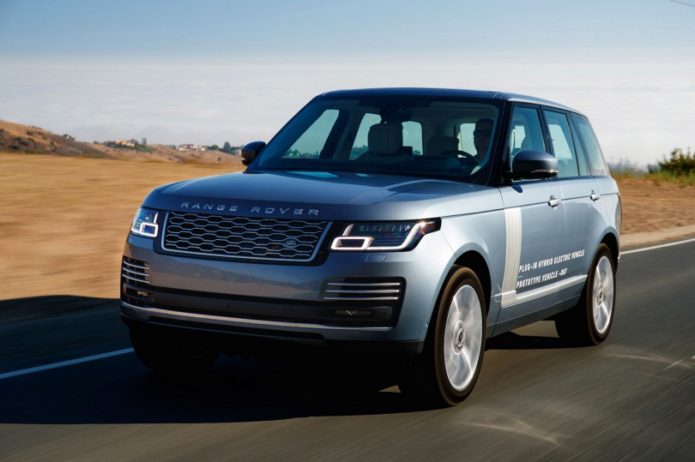There’s now a full-size Range Rover featuring plug-in hybrid technology. We’ve driven an early prototype to see if it makes sense
Land Rover’s flagship Range Rover model is being overhauled for 2018 with changes that run far deeper than a quick glance at the exterior styling would suggest.

The star attraction is the addition of this company car tax-friendly plug-in hybrid version, called the P400e. It’s Land Rover’s first plug-in hybrid system, and it mixes a 296bhp petrol engine with a 114bhp electric motor and battery pack.
It’s officially good for average fuel economy of 101mpg and CO2 emissions of 64g/km, comfortably making it the most economical model in the range on paper. It can also run on electric power only for up to 31 miles, a full recharge of the battery taking 2hr 45min with a fast charger.

2017 Range Rover P400e on the road
Our test in the P400e was a brief one, and of an early prototype car. Land Rover says it’s about 95% representative of a production car, but that remaining 5% will make all the difference between it being an okay car and a good one.
That’s because, at present, the ride isn’t comfortable enough, and nor is the seamless shifting and integration between electric and petrol power that would give the car the kind of comfortable, effortless drive you’d expect of a Range Rover. None of this, however, is news to Land Rover, which pre-empted all these changes as ones that are being made anyway.
[su_youtube url=”https://youtu.be/GZLxGdtswbQ”]
Indeed, a Range Rover Sport P400e that we also briefly tried was more representative of a finished car, with the correct suspension settings to compensate for the extra weight of the hybrid system and much better integration between the electric motor and petrol engine when delivering power.

2017 Range Rover P400e interior
New hybrid engine option aside, the major changes to the 2018 Range Rover take place in its cabin, all designed to bring greater levels of comfort and luxury.
To that end, there are new front seats, asymmetrical in design to allow the driver to slide onto them easier. Once you’re there, the seats are bigger and more comfortable than before and the control switches to operate their electrical adjustment have been relocated to the door panel for greater ease of use.
You will not want for comfort. Nor will you want for technology, because Land Rover has given its flagship model a new dual-screen infotainment option from the smaller Range Rover Velar. It’s feature-packed but isn’t the most intuitive to use until you’ve mastered the various screens and functions.
Rear seat passengers also benefit from new seats with greater adjustability, but leg room remains deceptively tight, given how big the car is from the outside. A long-wheelbase model helps to address that.
Oddment storage is also increased in the cabin, with more small storage areas added and the fridge between the driver and passenger seats increased in size to house 500ml bottles that can be chilled. Other tweaks include a sunblind for the panoramic roof that can be operated by gesture controls and an air filter to improve cabin air quality.
The overall impression of the cabin is one of incredible luxury and comfort, and it remains the car’s key selling point. It is one of the most relaxing environments in which to sit and drive a car.

Land Rover is well on its way to creating a Range Rover with much greater appeal, especially with company car drivers, but there is work to be done to the plug-in hybrid powertrain. Land Rover must ensure the refinement of the powertrain is improved by the time it makes production to match the quality and calming nature of its cabin.
For those unable to take advantage of the company car tax savings, the entry-level 254bhp TDV6 diesel is likely to remain the pick of the range, coming in at some £7000/$9310 less than the hybrid in base Vogue form (£79,595/$105,860).
Range Rover P400e PHEV specs
- Price £86,965/$115,664
- Engine 4cyl, 1997cc, petrol, plus electric motor
- Power 398bhp (combined)
- Torque 472lb ft (combined)
- Gearbox 8-spd automatic
- 0-62mph 6.4sec
- Top speed 137mph
- Economy 101mpg (official average)
- CO2, tax band 64g/km, 13%
(whatcar.com, https://goo.gl/Hqt6u8)


